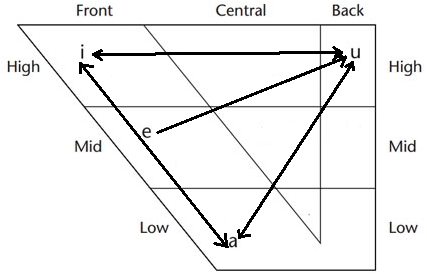Difference between revisions of "Ati"
(→Syntax) |
(→Numbers) |
||
| Line 90: | Line 90: | ||
=Lexicon= | =Lexicon= | ||
==Numbers== | ==Numbers== | ||
| + | Base-10. The place value of a digit is given by the smallest value for that place in the following morpheme, ie "Fifty-four" literally translates to "five-ten-four". | ||
| + | |||
{| class="wikitable" style="text-align:center; vertical-align:middle; width:300px;" | {| class="wikitable" style="text-align:center; vertical-align:middle; width:300px;" | ||
|1 | |1 | ||
Revision as of 14:45, 18 October 2015
Contents
Phonology
Consonants
The consonant system was developed with a serious look at Hawaiian, which has one of the smallest consonant inventories in the world. Unlike Asi, Hawaiian lacks /k/; [k] is an allophone of /t/. This is unusual in the world's languages, though, and speakers can distinguish the two phones with relative ease.
I included only one fricative as there is an entire language family that almost entirely lacks fricatives. Of the four modes of articulation, fricatives are also the most difficult to learn to produce.
The two most common nasals of the world are included as separate phonemes. Although they are difficult to distinguish to the ear, there are few languages that only contain one nasal. Those that do often have nasalized vowels, which Asi lacks, although a nasalized vowel may be considered allophonic with /n/ in coda.
Asi contains one more approximant than the language with the fewest approximants, and that is /r/. I've included it because that language does retain vowel lengthening, so the inclusion of /r/ allows for that possibility for speakers who are accustomed to vowel length being differentiating, while still being understandable as a rhotic to other speakers.
There are 8 consonants in total, which is equal to the number in Hawaiian.
| Labial | Alveolar | Palatal | Velar | Glottal | |
|---|---|---|---|---|---|
| Plosive | p | t | k | ||
| Nasal | m | n | |||
| Fricative | s | ||||
| Approximant | w | j | r1 |
- Can be realized as any rhotic, rhoticization or lengthening of previous vowel, depending on the position and speaker.
Vowels
There are many languages that in theory only have three vowels: /a/, /i/, and /u/. However, these languages often have diphthongization that adds /e/ (ie Blackfoot) or dialects that include /e/ (ie Arabic) that is recognizable to other speakers. This is sensible, as looking at a vowel chart, it is a further distance from /a/ and /i/ than any back vowel from /u/ and /a/. Asi's vowel system will be ruled by measurements of these distances.
| Front | Back | |
|---|---|---|
| Close | i | o |
| Mid | e | |
| Open | a | |
Phonotactics
Many languages only allow for CV syllables, ie Hawaiian, Japanese, Blackfoot, and Pali. By my understanding, though, all of these languages have wiggle room: casual Hawaiian speech frequently omits vowels, Japanese allows for /N/ in coda and some consonants followed by voiceless vowels (ie su) can be analyzed as syllabic consonants, and Pali allows for gemination.
Asi is going to be more restrictive, allowing for consonantal codas only word-finally so that they may be followed by a voiceless high vowel or schwa if the speaker finds that particular coda difficult. It allows for /n/ or /m/ in coda position word-medially (regressively assimilating place from the following onset), which may be realized as a nasalized vowel.
Syllable structure is therefore (C)V(C#) or (C)V(N).
V may be made up of a single vowel or a combination of two vowels of sufficient distance (ai, ao, eo, ia, io). Note that because of its proximity to schwa, no diphthong or vowel combination ends in /e/, to avoid confusion with a long vowel that may be realized as a vowel with a schwa offglide.
Syntax
As languages acquire more second-language learners, they become grammatically simpler and more analytical. Asi will therefore be entirely analytical, with a single morpheme to a word.
While SOV is a slightly more common word order, SVO language speakers greatly outnumber those of SOV languages. Asi will be SVO and will follow right-branching grammatical rules.
Verbal Grammar
Many languages do not contain a future tense. Aspect is not common enough to replace tense in Asi. The past-tense particle, preceding the verb, is ta.
Negative - ne, preceding the negated phrase.
Nominal Grammar
Asi lacks nominal grammar completely at this point. Plurality, though common, is difficult to understand for speakers of languages without it. Gender is unnecessary and possession will be marked by a particle wo following the possessor, in a phrase preceding the head noun.
Lexicon
Numbers
Base-10. The place value of a digit is given by the smallest value for that place in the following morpheme, ie "Fifty-four" literally translates to "five-ten-four".
| 1 | pi |
| 2 | te |
| 3 | oki |
| 4 | ma |
| 5 | nina |
| 6 | ase |
| 7 | soso |
| 8 | awa |
| 9 | jai |
| 10 | ren |
| 54 | nina-ren-ma |
Mood Particles
Mood particles are sentence-initial.
| Interrogative | ka |
|---|---|
| Potential | mai |
| Subjunctive | osi |
Prepositions
Open Class
https://docs.google.com/spreadsheets/d/19KLyPuiCVs3eKDb2YlZBjtjbyeCOcWCelEOLeduBlYo/edit#gid=0
